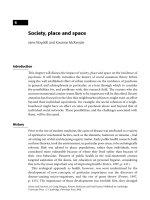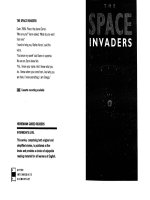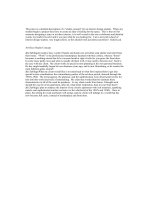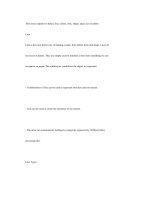space uranus
Bạn đang xem bản rút gọn của tài liệu. Xem và tải ngay bản đầy đủ của tài liệu tại đây (7.53 MB, 65 trang )
spine=10mm
Uranus
sherman
Space: Uranus - 27578
CPL609-15 / 4228 2nd proof
SPACE_CV R_Uranus_.indd 03/06/2009
Asteroids, Meteors, and Comets
The Dwarf Planet Pluto
Earth and the Moon
Jupiter
Mars
Mercury
Neptune
Saturn
The Stars
The Sun
Uranus
Venus
Titles in This Series
Uranus was the seventh planet to be discovered, and is the only
one tilted almost completely on its side. This blue-green planet is
a gas giant with twenty-seven known moons and more than ten
rings. Uranus explores these planetary features and is full of many
other fascinating facts. Learn about new discoveries, innovative
technologies, and incredible explorations that have given us many
answers to our questions about outer space. So come along on this
incredible journey through Space!
Josepha Sherman
Uranus
1
Space ! Uranus - 27578
PL409-76 / 4228
1
1
1
1
1
1
uranus
JOSEpHa SHErMaN
SPACE_INT_Uranus_.indd 1SPACE_INT_Uranus_.indd 1 22/04/2009 7:45 AM22/04/2009 7:45 AM
Marshall Cavendish Benchmark
99 White Plains Road
Tarrytown, New York 10591
www.marshallcavendish.us
Text copyright © 2010 by Marshall Cavendish Corporation
All rights reserved. No part of this book may be reproduced or utilized in any form
or by any means electronic or mechanical including photocopying, recording, or by
any information storage and retrieval system, without permission from the copyright
holders.
All websites were available and accurate when this book was sent to press.
Library of Congress Cataloging-in-Publication Data
Sherman, Josepha.
Uranus / by Josepha Sherman.
p. cm. (Space!)
Summary: “Describes Uranus, including its history, its composition, and its role in the
solar system” Provided by publisher.
Includes bibliographical references and index.
ISBN 978-0-7614-4558-6
1. Uranus (Planet) Juvenile literature. 2. Herschel, William, Sir, 1738-1822 Juvenile
literature. I. Title.
QB681.S54 2010
523.47 dc22
2008037274
Editor: Karen Ang
Publisher: Michelle Bisson
Art Director: Anahid Hamparian
Series Design by Daniel Roode
Production by nSight, Inc.
Front cover: A computer illustration of Uranus
Title page: A spacecraft does a fl yby past Uranus.
Photo research by Candlepants, Inc.
Front cover: Chris Bjornberg / Photo Researchers Inc.
The photographs in this book are used by permission and through the courtesy of:
Corbis: 1; Bettmann, 30. Super Stock: Digital Vision Ltd., 4, 5. The Image Works: SSPL, 7,
11; Mary Evans Picture Library, 13(right). Getty Images: Time & Life Pictures, 8, 32; Kauko
Helavuo, 16; AF P, 22; National Geographic, 29(lower), 41; 23, 35, 38, 49; Joe McNally, 52.
NASA: A. Zezas and J. Huchra (Harvard-Smithsonian Center for Astrophysics), 13(left);
J PL, 20, 28-29, 31, 34, 37, 40; J PL/STScI,50, 58. New York Public Library: Picture Collection,
Astor, Lenox and Tilden Foundations, 14. Photo Researchers Inc.: Roger Harris, 18, 19;
Mark Garlick, 25, 36, 42, 43, 46; California Association for Research in Astronomy, 57.
Calvin J. Hamilton: 26, 27. AP Images: NASA, 53. European Space Agency: 55. Illustration
on page 45 by Mapping Specialists © Marshall Cavendish.
Printed in Malaysia
123456
Space ! Uranus - 27578
CPL509-66 / 4255
2nd Proof
SPACE_INT_Uranus_.indd 2SPACE_INT_Uranus_.indd 2 27/05/2009 5:48 PM27/05/2009 5:48 PM
Chapter 1 An Unexpected Discovery 5
Chapter 2
The Mystery Planet 19
Chapter 3
New Discoveries 27
Chapter 4
Exploring the Planet 43
Quick Facts about Uranus 58
Glossary 59
Find Out More 60
bibliography 61
Index 62
Space ! Uranus - 27578
PL409-76 / 4228
SPACE_INT_Uranus_.indd 3SPACE_INT_Uranus_.indd 3 22/04/2009 7:45 AM22/04/2009 7:45 AM
Space ! Uranus - 27578
PL409-76 / 4228
SPACE_INT_Uranus_.indd 4SPACE_INT_Uranus_.indd 4 22/04/2009 7:45 AM22/04/2009 7:45 AM
Scientists did not know about Uranus’s many features until the creation of
powerful telescopes and spacecraft that could travel near the planet. This
image of Uranus was taken by the
Voyager 2
spacecraft in 1986.
1
an Unexpected
Discovery
In the eighteenth century, people believed that there were only
six planets in our Solar System. These planets were Mercury,
Venus, Earth, Mars, Jupiter, and Saturn. No new planets had
been discovered for nearly two thousand years because the
technology was not good enough.
With the observation equipment available at that time, no one
could search deeply into space. People had long been interested
in objects in space, but astronomy was still a new science in the
eighteenth century. There were no such things as ready-made
telescopes available in markets. Scientists had to make their
own. Anyone wanting to see the stars through a telescope had
to either be very good at making things, such as grinding glass
lenses, or rich enough to get someone to make a telescope for
him or her.
5
5
5
5
5
5
5
Space ! Uranus - 27578
PL409-76 / 4228
SPACE_INT_Uranus_.indd 5SPACE_INT_Uranus_.indd 5 22/04/2009 7:45 AM22/04/2009 7:45 AM
6
uranus
Space ! Uranus - 27578
CPL509-66 / 4255
THE MUSICAL ASTRONOMER
William Herschel had never really expected to be an astronomer.
Born on November 15, 1738, as Friedrich Wilhelm Herschel, he was
part of a musical family in Germany. At fi rst, he fully intended
to follow in the family tradition. He became a fi ne singer, and
his sister Caroline often joined him in duets. Then Herschel’s
life changed dramatically. He tried military life as a teenager,
but realized that he did not want to stay in the military. In 1757,
at the age of nineteen, Herschel left Germany forever. He had
visited England once and liked it, and he could already speak
English, so he headed there.
Herschel became a British citizen and changed his name from
Friedrich Wilhelm Herschel to the more English-sounding Fred-
erick William Herschel. He took a job as a music teacher to make
a living, performing the violin, the oboe, and the organ. The busy
Herschel also composed music. In 1772, he persuaded his sister,
Caroline, also interested in music, to join him in England.
Music is made up of specifi c beats and notes, and Herschel
and his sister began to study mathematics to help him with his
compositions. Through mathematics they became fascinated
with the relatively new science of astronomy. Among the books
that they owned were Robert Smith’s 1738 book, The Compleat
System of Optiks—the branch of science that deals with the prop-
erties of light—and James Ferguson’s 1756 book, Astronomy.
2nd Proof
SPACE_INT_Uranus_.indd 6SPACE_INT_Uranus_.indd 6 27/05/2009 5:49 PM27/05/2009 5:49 PM
Space ! Uranus - 27578
PL409-76 / 4228
The Telescopes of
Herschel’s Time
The fi rst refl ecting telescope was designed by
the Scottish scientist James Gregory, who lived
in the 1600s. But it was not a perfectly work-
ing device. The next effective telescope inventors
were two English scientists from
the seventeenth century. Robert
Hooke was noted for both his
telescopes and microscopes, and
Sir Isaac Newton was an astrono-
mer, mathematician, and physicist.
Then, in the 1720s, Englishman
John Hadley, with the help of
his brothers George and Henry,
built the fi rst useful refl ecting tele-
scopes. Since he made a thorough
study of the science of optics and
telescopes, Herschel would have
known about all of these and used
that knowledge when building his
own telescopes.
This 7-foot-long telescope
was made in 1783 by
William Herschel.
SPACE_INT_Uranus_.indd 7SPACE_INT_Uranus_.indd 7 22/04/2009 8:02 AM22/04/2009 8:02 AM
Herschel and his sister Caroline used telescopes to chart
the features and movement of different celestial bodies.
Space ! Uranus - 27578
PL409-76 / 4228
8
SPACE_INT_Uranus_.indd 8SPACE_INT_Uranus_.indd 8 22/04/2009 7:46 AM22/04/2009 7:46 AM
9
an Unexpected Discovery
Space ! Uranus - 27578
CPL509-66 / 4255
Herschel was quoted as saying, “Among other mathematical
subjects astronomy came in turn . . . I was so delighted with the
subject that I wished to see the heavens and planets with my
own eyes thro’ [a telescope].” This meant that, like all the other
astronomers of his time, Herschel had to build his own tele-
scope. He read Smith’s book from cover to cover and studied all
he could learn about optics and the making of telescope lenses,
and then he put together several test telescopes. Herschel fi nally
built such a good telescope that even the professional astron-
omers at London’s Royal Observatory announced that they
could not make a better one. Herschel’s telescope is a refl ecting
telescope, which magnifi es far-off objects using mirrors rather
than glass lenses. Light enters the telescope and is refl ected
twice before it enters the eyepiece.
Music—and getting paid for his music—was still Herschel’s
way of making a living. However, his spare time was now
completely fi lled with his astronomical observations. Herschel
had quickly realized that no one had made a comprehensive
celestial atlas—an atlas of all the objects in space. Herschel’s
goal was to make one. He was particularly interested in making
a catalog of double stars, which are two stars that seem to
be almost in line. Herschel was planning to use the data he
was collecting to calculate the distance from Earth to a star,
something no one had ever been able to do.
2nd Proof
SPACE_INT_Uranus_.indd 9SPACE_INT_Uranus_.indd 9 27/05/2009 5:49 PM27/05/2009 5:49 PM
10
uranus
Space ! Uranus - 27578
CPL509-66 / 4255
In 1781, Herschel began spending each night making a careful,
measured study of a different part of the sky, marking down
everything he saw in each section. He saw single and double
stars, comets, and fi ve of the six known planets—Mercury,
Venus, Mars, Jupiter, and Saturn. Everything seemed in order.
A SURPRISE DISCOVERY
Then on March 13, 1781, Herschel found a strange object in the
night sky that did not seem to fi t the regular pattern. It did not
move or act like a star. At fi rst, he thought that what he was
seeing had to be either a comet or a nebulous star, which is a
star that is seen through a nebula, or a dust cloud in space. It
did not occur to Herschel that he had found a new planet. He
told other astronomers about what he had found, and they, too,
thought it surely was only a comet.
By the summer of 1781, more detailed observations were made
by another astronomer, Anders Johann Lexell. Other astrono-
mers made their calculations as well. It was proven that this
strange object orbited around the Sun, just like other planets.
Herschel had indeed discovered that there was a seventh planet
in the Solar System.
The news was truly amazing. It was in all the newspapers
and in everyone’s conversations. The size of our Solar System
had suddenly doubled, and it now seemed almost unbelievably
1
1
1
1
0
0
0
0
0
10
2nd Proof
SPACE_INT_Uranus_.indd 10SPACE_INT_Uranus_.indd 10 27/05/2009 5:49 PM27/05/2009 5:49 PM
An eighteenth-century planetary chart shows the recorded
features and characteristics of the seven known planets. Here,
Uranus is called “Herschel.”
11
Space ! Uranus - 27578
PL409-76 / 4228
SPACE_INT_Uranus_.indd 11SPACE_INT_Uranus_.indd 11 22/04/2009 7:46 AM22/04/2009 7:46 AM
Space ! Uranus - 27578
CPL509-66 / 4255
12
uranus
big. Uranus was as far from the sixth planet, Saturn, as Saturn
was from Earth. All the information about our Solar System
now had to be updated. As further studies of Uranus were
made, astronomers realized that previous scholars had noticed
it as far back as 1690. But those earlier astronomers were using
weaker telescopes, and they all thought that what they saw was
just another star.
Scientists around the world praised Herschel for his discovery.
King George III knighted Herschel and gave him and Caroline the
titles of “The King’s Astronomer” and “Assistant to the King’s
Astronomer,” an honor which came with a lifetime salary for
them both. He also gave them their own private observatory.
Now Herschel and his sister were free to become full-time
astronomers. Herschel also became a telescope maker.
Naming the Planet
At fi rst, no one knew what to name this new planet. Herschel
wanted to name it Georgium Sidus, or George’s Star, after King
George III of England, who was giving Herschel money for his
studies of astronomy. None of the other astronomers really
liked that name, particularly since what had been found was a
planet, not a star. Some astronomers wanted to call it Herschel
after its discoverer, but that did not catch on.
2nd Proof
SPACE_INT_Uranus_.indd 12SPACE_INT_Uranus_.indd 12 27/05/2009 9:22 PM27/05/2009 9:22 PM
Space ! Uranus - 27578
PL409-76 / 4228
Johann bode
German astronomer Johann Elert Bode also became
interested in astronomy through mathematics. In late 1774,
Bode began looking for star clusters in the sky, and observed
twenty of them. Among his fi nds
are three original discoveries: M81
(also known as Bode’s Galaxy) and
M82, both of which he discovered
on December 31, 1774; and M53,
which he discovered on February 3,
1775. He discovered numerous other
star clusters and helped to calculate
the orbit of Uranus.
Johann Bode
M81, or Bode’s Galaxy, viewed from the
Hubble Space Telescope.
SPACE_INT_Uranus_.indd 13SPACE_INT_Uranus_.indd 13 22/04/2009 7:46 AM22/04/2009 7:46 AM
An artist’s
depiction
of Uranus,
from whom
all other
gods and
goddesses
descended.
14
uranus
Space ! Uranus - 27578
PL409-76 / 4228
Finally, Johann Bode pointed out that the other planets had
mythological names, such as Saturn and Jupiter. Bode thought
that the new planet should be named Uranus. In Greek and
Roman mythology, Uranus was known as the god of the sky. Most
of the other Greek and Roman gods and goddesses descended
from Uranus.
Some of the other astronomers agreed with the suggested
name, while others did not. Some astronomers called it “the
SPACE_INT_Uranus_.indd 14SPACE_INT_Uranus_.indd 14 22/04/2009 2:13 PM22/04/2009 2:13 PM
15
an Unexpected Discovery
Space ! Uranus - 27578
PL409-76 / 4228
Georgian planet,” and still others called it “Herschel.” It took
a full sixty years of arguing over the name before astronomers
agreed to call the seventh planet Uranus.
ANOTHER SURPRISE
DISCOVERY
In 1787, Herschel made another discovery about Uranus. He found
two moons orbiting it. By that time, not all celestial bodies were
being named after Roman mythology. As a result, Herschel’s two
moons were named Titania and Oberon. Those were the names
of the queen and king of fairies in William Shakespeare’s play
A Midsummer Night’s Dream.
Herschel thought that there might be four other moons
orbiting Uranus, but he could not fi nd any way to prove it. The
trouble was that even though Herschel was building some of
the fi nest and largest telescopes in the world, there was still a
great deal that he simply could not see. The distances were too
great and even the best telescopes of the time were not very
strong. The images were just too faint for him to make accurate
calculations. Herschel also thought that he had glimpsed rings
around the planet, like the rings of Saturn. However, since the
image he saw was so blurry, he suspected that the “rings” were
just a trick of the light.
SPACE_INT_Uranus_.indd 15SPACE_INT_Uranus_.indd 15 22/04/2009 2:16 PM22/04/2009 2:16 PM
16
uranus
Space ! Uranus - 27578
PL409-76 / 4228
There was one more surprise for William Herschel and his
fellow eighteenth-century astronomers. When they studied the
orbits of Oberon and Titania they expected to fi nd that the two
moons orbited around Uranus’s equator. (That is where our
Moon and the other planets’ moons orbit.) But that did not work
An artist’s illustration shows how the young planet Uranus might
have been struck by a large object, like an asteroid, causing the
planet to tilt.
SPACE_INT_Uranus_.indd 16SPACE_INT_Uranus_.indd 16 22/04/2009 2:14 PM22/04/2009 2:14 PM
17
an Unexpected Discovery
Space ! Uranus - 27578
PL409-76 / 4228
out for Oberon and Titania because Uranus’s equator appeared
to be different from equators of other planets. This meant that
Uranus was tilted onto its side, with its North Pole on one end
and the South Pole at the other. None of the other planets the
astronomers had studied had more than a small tilt. What could
have happened to Uranus? They could only guess that a large
body, maybe a huge asteroid, had slammed into the planet and
tilted it. That theory never has been proved or disproved.
SPACE_INT_Uranus_.indd 17SPACE_INT_Uranus_.indd 17 22/04/2009 2:14 PM22/04/2009 2:14 PM
Space ! Uranus - 27578
PL409-76 / 4228
SPACE_INT_Uranus_.indd 18SPACE_INT_Uranus_.indd 18 22/04/2009 7:44 AM22/04/2009 7:44 AM
2
The Mystery
Planet
Uranus remained a mystery planet for more than a century
after it was discovered. The biggest problem—even though
telescopes were slowly improving—was the great distance
between Earth and Uranus. Even when it is as close to Earth as
its orbit allows and viewed through a good telescope, Uranus
seems to be a disk with a diameter of only about 4 inches (10
centimeters.) There is a good reason for this. Uranus is about
1.69 billion miles (2.72 billion kilometers) from Earth. This is
more than eighteen times as far as the distance between Earth
and the Sun.
More Uranus discoveries were made in the nineteenth
century. British astronomer William Lassell found two more of
Uranus’s moons in 1851. He named them Ariel and Umbriel. The
As the seventh planet from the Sun, it is not surprising that Uranus can be
diffi cult to see from Earth, which is only the third planet from the Sun.
19
Space ! Uranus - 27578
PL409-76 / 4228
1
1
1
1
9
9
9
9
19
SPACE_INT_Uranus_.indd 19SPACE_INT_Uranus_.indd 19 22/04/2009 7:44 AM22/04/2009 7:44 AM
20
uranus
Space ! Uranus - 27578
PL409-76 / 4228
name Ariel is from Shakespeare’s
works, and follows the theme used
in naming Titania and Oberon.
However, Umbriel is a character in
a poem by English poet Alexander
Pope.
After Lassell’s discovery, there
came another long stretch of time
where nothing new was learned
about Uranus. In 1948, American
astronomer Gerard Peter Kuiper
discovered another moon orbit-
ing Uranus. He named it Miranda,
which is another name taken from
Shakespeare. It was thought at
the time of discovery—since no
one could prove otherwise—that
Miranda was the moon closest to
Uranus. It would be years before
more information was discovered.
THE SPACE RACE
A combination of scientifi c curiosity and international problems
brought about a new space organization for the United States,
Miranda was fi rst
noticed in 1948, but
obtaining detailed
images of the moon’s
surface only became
possible when the
spacecraft
Voyager 2
fl ew by Uranus in the
1980s.
SPACE_INT_Uranus_.indd 20SPACE_INT_Uranus_.indd 20 22/04/2009 7:48 AM22/04/2009 7:48 AM
21
The Mystery Planet
Space ! Uranus - 27578
PL409-76 / 4228
and a new chance for astronomers to make discoveries. The
United States had been thinking about going into space and
exploring it for years. One of the main reasons was curiosity,
but the other reason was the Cold War. That was a war without
fi ghting between the United States and what was then the Soviet
Union, made up of Russia and its conquered countries. As part
of the Cold War, the United States and the Soviet Union became
involved in a “space race,” mostly to see who would be the fi rst
to land a man on the Moon.
In 1957, the Soviet Union launched Sputni k 1, the fi rst artifi cial
satellite. That spurred the United States to action. In 1958,
NASA, the National Aeronautics and Space Administration, was
formed. Its mission was to achieve great scientifi c and technical
goals in the air and in space. Among those goals were manned
space fl ight, and the landing of men on the Moon. Thanks to
NASA, men did land on the Moon several times, from 1969 to
1972.
There were many other missions that the scientists at NASA
wanted to accomplish. Scientists at the agency wanted to know
more about the Solar System. Unfortunately, most of the planets
were just too far away for manned missions. A person would die
of old age long before he or she ever reached the outer planets
in a spacecraft. Scientists had to mostly rely on satellites and
other Earth- or space-based telescopes for information about
and images from outer space.
SPACE_INT_Uranus_.indd 21SPACE_INT_Uranus_.indd 21 22/04/2009 7:48 AM22/04/2009 7:48 AM
Space ! Uranus - 27578
CPL509-66 / 4255
The Cold War
This is the name for the era of competition and tension
between the United States and the Soviet Union, and
both sides’ allies. It lasted from about 1945 until the
early 1990s. The United States and the Soviet Union
“fought” the cold war in many ways, including spying,
military buildups, a dangerous nuclear weapons race, and
the space race. Today, the United States and Russia are
allies in the space program, and are both involved in the
construction of the International Space Station.
In addition to
launching the fi rst
artifi cial satellite,
the Soviet Union
was also the fi rst
to send a living
creature into space.
The dog named
Laika was sent into
space in 1957.
2nd Proof
SPACE_INT_Uranus_.indd 22SPACE_INT_Uranus_.indd 22 27/05/2009 7:16 PM27/05/2009 7:16 PM
23
The Mystery Planet
Space ! Uranus - 27578
PL409-76 / 4228
VOYAGER 1 AND VOYAGER 2
Planets like Uranus were too far away for any manned missions,
but NASA began planning for two related unmanned missions
to visit far-off planets. They began work on the design of twin
spacecraft, named Voyager 1 and Voyager 2.
At the time, the two spacecraft, identical in every aspect,
were two of the most sophisticated robot crafts ever built. Each
carried its own power and propulsion, as well as scientifi c
instruments and communications systems that would keep them
A NASA
diagram
from 1977
shows the
different
features of
the
Voyager
spacecraft.
SPACE_INT_Uranus_.indd 23SPACE_INT_Uranus_.indd 23 22/04/2009 2:14 PM22/04/2009 2:14 PM
24
uranus
Space ! Uranus - 27578
PL409-76 / 4228
in touch with the NASA scientists on Earth. Each Voyager had
a series of connected computer “brains” that allowed the craft
to operate on its own for weeks. The “brains” even included the
ability to fi nd and correct errors before the NASA scientists
were aware of them. Everyone hoped that the two spacecraft
would fi nally answer some questions about the more distant
planets in our Solar System, including Uranus.
The twin Voyagers were launched in summer of 1977 from
the NASA Kennedy Space Center at Cape Canaveral, Florida.
Voyager 2 was launched fi rst, on August 20, 1977. Voyager 1 was
launched on a faster, shorter fl ight on September 5, 1977. The
two spacecraft were originally designed to carry out close-up
studies of Jupiter and Saturn and those planets’ larger moons.
However, they performed so well that their missions were
extended to cover visits to Uranus and Neptune as well.
One of the main reasons that the missions could be extended
over such great distances was a rare arrangement of the four
planets, Jupiter, Saturn, Uranus, and Neptune. This arrangement
only happens every 175 years. It meant that a spacecraft could
swing around one planet to the next, taking advantage of one
planet’s gravity to move it to the next planet. This “gravitational
assist” is like a slingshot adding extra speed to a spacecraft. This
allows the spacecraft to travel without too much extra fuel.
After Voyager 2 had carried out its successful encounter
with Saturn, NASA scientists were certain that the spacecraft
SPACE_INT_Uranus_.indd 24SPACE_INT_Uranus_.indd 24 22/04/2009 7:48 AM22/04/2009 7:48 AM









